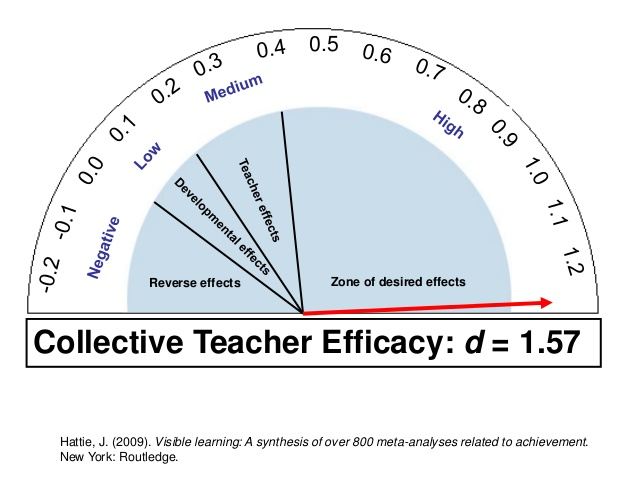There is a new number one in town – teacher collective efficacy. According to John Hattie, in his most recent iteration of his massive meta-analyses synthesis, this category has a whopping effect size of 1.57 and tops the list of over 250 influences.
What does teacher collective efficacy mean? It means we believe we can cause learning. It means a team of teachers believes that they add value through their actions by working together effectively. More officially it means, “collective self-perception that teachers in a given school make an educational difference to their students over and above the educational impact of their homes and communities.” (Tschannen-Moran & Barr, 2004, p. 190) This idea seems simple at the surface level. If you ask almost any teacher or team of teachers, they would tell you that they make a positive impact on student learning. But what about when the door closes? What does a teacher tell themselves? What does a team truly believe? If the answer remains the same then a team is on the path to true teacher collective efficacy….and the learners reap the rewards.
This idea seems simple at the surface level. If you ask almost any teacher or team of teachers, they would tell you that they make a positive impact on student learning. But what about when the door closes? What does a teacher tell themselves? What does a team truly believe? If the answer remains the same then a team is on the path to true teacher collective efficacy….and the learners reap the rewards.
Note that this is not a discussion about whether or not our students can attain achievement through our collective teacher efficacy. Our job is to add value, add growth. Many students have attained achievement standards for a grade level before they even walk into our classrooms on the first day while other students can get there not long after. Other students may need more than one year’s time to reach grade level
Identifying and replicating teacher teams with high collective efficacy is compounded by the fact that they are often humble in identifying themselves. Ask a master teacher or team why they think their kids did so well. The answers will include hard-working students, great parents, helpful resources, etc. The question Hattie poses is “how often do teachers say the kids did well because of them?” Answer: not often. Teachers will increase their impact by owning their successes. Educational leaders can also serve a role in curbing this humility and attributing success to teachers. Let’s scale up these successes and promote the growth of an even larger number of teacher teams.
This area of research and many of the other top items in Hattie’s research are dominated by teacher expertise. Hattie argues, rightfully so, that school systems do not do enough to prioritize this reality and put the spotlight on the teachers with the right expertise. The reality is that we cannot choose the students we have, but we can select and/or develop the best teachers and teacher teams. As teachers, we can aspire to maximize our time and functionality in professional learning communities and professional development and growth experiences. As school leaders, we need to have the courage to identify teachers of expertise and build a coalition around them.





Leave a Reply